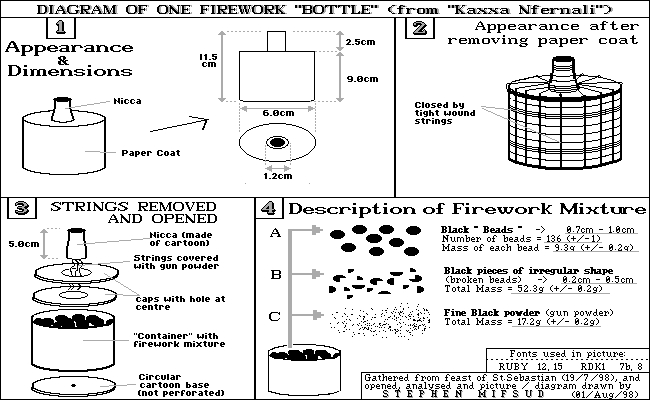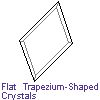

|
||
CHEMISTRY : Pyrotechnics (FireWorks)
Chemical Analysis of Firework Material
| PROJECT CODE: | 5.01 |
| SECTION: | Chemical Analysis of firework material |
| PROJECT TITLE: | Murtal tal-bomba tal-kaxxa nfernali (dawl abjad) |
| SAMPLE SOURCE: | Saint Sebastian, Qormi |
| RELEASE DATE: | 21-23 July 99 |
| LAST UPDATE: | 12 September 99 |
| VERSION HISTORY: | 1.0, 1.1 ( Context updates)
V1.2 (Text and formatting update - Sep-2009) |

| Measurment | Sample 1 | Sample 2 | ||
|---|---|---|---|---|
| Wood Chips | Gunpowder | Wood Chips | Gunpowder | |
| Volume (Cm3) | 110 | 90 | 135 | 100 |
| Weight (g) | 20 | 65 | 13 | 80 |
Mass of Soluble solids = (Mass of mixture) - (Mass of undissolved solids)
| TEST | Weight of Sample Mixture (g) |
Weight of Unsoluble Solid (g) |
Percentage | Weight of Soluble Solid (g) |
Percentage |
|---|---|---|---|---|---|
| TEST 1 | 5.00 | 2.34 | 47% | 2.66 | 53% |
| TEST 2 | 5.00 | 2.35 | 47% | 2.65 | 53% |
| TEST 3 | 10.00 | 4.45 | 45% | 5.55 | 55% |
| TEST 4 | 5.00 | 2.23 | 45% | 2.77 | 55% |

| Nitric Acid | Sulphuric Acid | Hydrochloric Acid |
|---|---|---|
| On adding nitric acid, there was no effervescence, or heat given off, but the colour changed to yellow and chlorine could be detected - not as strong as in the other acids. | On adding sulphuric acid, there was a crackling reaction. On adding few drops more, there was effervescence, and heat while the viscous solution turned brown yellow, and a green gas - Chlorine - was evolved. | On adding hydrochloric acid, there was no explosive reaction, but there was effervescence, and the colour turned yellow-green with the production of chlorine. |
| Solution | Concentration | Method of Preparation) |
|---|---|---|
| Sol A | 100% H Cl | 4.0 mls conc HCl |
| Sol B | 50% H Cl | 2.0 mls conc HCl + 2mls water |
| Sol C | 25% H Cl | 1.0 mls conc HCl + 3mls water |
| Sol D | 10% H Cl | 0.8 mls conc HCl + 7.2mls water |
| Sol E | 5% H Cl | 4.0 mls of the above solution + 4mls water (*) |
| Sol F | 2.5% H Cl | 4.0 mls of the above solution + 4mls water (*) |
| (*) = serial dilution | ||
| Sample | Mixture Weight (g) |
Reacted solid Weight (g) |
Percentage | Unreacted deposit Weight (g) |
Percentage |
|---|---|---|---|---|---|
| A+B | 0.25 | 0.08 | 32% | 0.17 | 68% |
| C+D+E | 0.25 | 0.07 | 28% | 0.18g | 72% |
| X | 0.65g | 0.15g | 23% | 0.50g | 77% |
| Y | 2.00g | 0.54g | 27% | 1.46g | 73% |
| Weight of Sulphur dissolved in 10ml Cold Chloroform | 0.18g / 10ml |
|---|---|
| Weight of Sulphur dissolved in 10ml Hot Chloroform | 0.48g / 10ml) |
| Weight of Sulphur dissolved in 10ml Cold Carbon TetraChloride | 0.09g / 10ml |
| Weight of Sulphur dissolved in 10ml Hot Carbon TetraChloride | approx 0.34g / 10ml |
| Mixture (Sample) | Metal | Sulphur | Wood | error loss % | |
|---|---|---|---|---|---|
| Weight (g) | 2.00 | 0.54 | 0.88 | 0.46 | 0.12 |
| Percent % | (100%) | 27% | 44% | 23% | 6% |
| Rounded Percent % | (100%) | 25% | 45% | 25% | 5% |
[ Chemistry Main Page ] - [ Qualitative & Quantitative Analysis ] - [ Pyrotechnics ] [ Cation ID ] - [ Chromatography ] - [ Crystal Study ] - [ Misc Documents ] - [ Chemistry Index Page ]